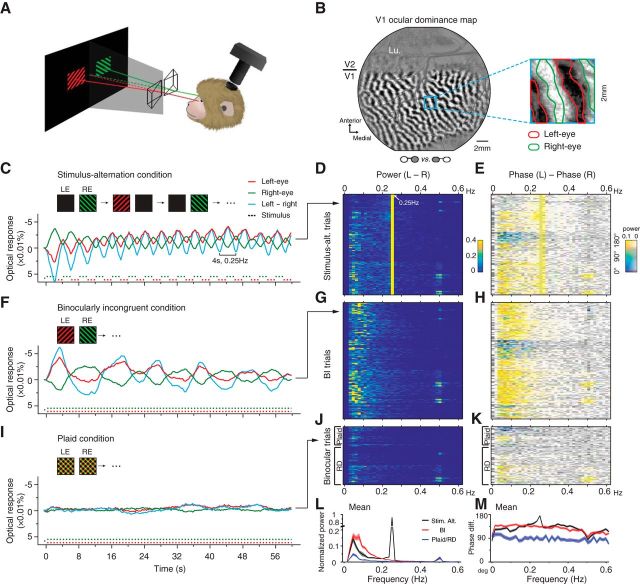Figure 1.
Optical imaging of the V1 response to a binocularly incongruent stimulus. A, Illustration of the visual stimulus and imaging setup. B, An OD map in V1 obtained by large monocular stimulations. A 2 × 2 mm region (blue frame) is magnified to show the outlines of left-eye and right-eye columns (inset). The actual stimulus ROI activated by BI stimulus normally occupied most of V1 surface in the chamber. Lu, Lunate sulcus. C, Example single-trial time courses of V1 left-eye (LE) pixels (red), right-eye (RE) pixels (green), and the difference between these two (cyan) in one stimulus-alternation trial. Negative was plotted upward because the negative optical-signal indicates a response increase. The response alternations follow the 4-s stimulus alternations (bottom traces). D, FFT power spectrums of L–R time courses (e.g., cyan curve in C) for 128 stimulus-alternation trials. Each row represents one trial. E, Phase differences between left-eye responses and right-eye responses for the same 128 trials shown in D, with saturation of the color code weighted by the corresponding power amplitudes. F–H, Similar to C–E, for BI data. Example time courses from a single-trial BI response show continuous fluctuations (F). Frequency analysis of all BI trials (n = 148) shows a distribution of fluctuation energy at 0.03–0.2Hz (G). Responses in the left- and right-eye domains are mostly antiphase (H). I–K, Similar to above, example trial and population results for two binocular control conditions (plaid and RD condition). Time courses of the responses to binocular plaid patterns are mostly flat (I). Population frequency analysis (n = 74) shows an absent of alternations (J) and only small interocular phase differences (K). L, M, Trial-averaged mean (±SEM) power spectrums (L) and phase spectrums (M, nonweighted) show differences between BI and plaid/RD conditions (two-way ANOVA, L, F(1,8800) = 217.04, p < 0.001; M, F(1,8800) = 915.79, p = 0).

